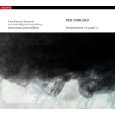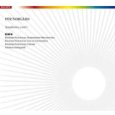Symphonies 3 and 7
Danish National Symphony Orchestra, Danish National Vocal Ensemble, Danish National Choir
Thomas Dausgaard, conductor
DaCapo Records
DaCapo has released a new recording of Per Nørgård’s Symphony #3, a masterpiece of color and structure to say the least. The only other recording of this work that I have ever encountered (and perhaps the only other recording) is the Chandos release paired with Nørgård’s piano concerto. The Chandos recording has served me well over the years and was a major contributor to me becoming a fan of Nørgård’s music. This new recording, however, is sonically superior in almost every respect. The sounds are sharper, crisper, and more detailed.
From the opening piano notes, through the glistening high-pitch descending lines, to the rich full brass and vibrant flexatone in the first three minutes, I felt like I was hearing this work for the first time again. The sonic clarity and crispness of the performance is perfectly stunning. The orchestra and voices perform with an infectious sense of joy and tranquility. I can’t listen to the piece without my stomach fluttering.
There are moments in the piece that I think are best left to recording, dare I say, instead of a live performance. This symphony is a work in which anything can and will happen. The organ’s entrance is a moment of musical perfection, especially when you don’t know it is going to happen (sorry to spoil the surprise). The same goes for the choir’s entrance 10 minutes into the second movement. You didn’t know that you wanted to hear voices until they emerge. Ulla Munch’s solo is buttery and lovely.
The disc also presents the world premiere recording of Nørgård’s Symphony #7. This composition is an excellent pairing to Nørgård’s Symphony #3 as there are many similar sonic elements but the overall tone is much darker with more drive. Instead of languishing in transcendant lush harmonies and colors from the symphony from the 70s, Nørgård’s most recent symphony (completed 2006) is full of agitation and motoric contraptions. The first movement’s molto agitato looses its steam for just a moment in the middle before winding back up again. Simple melodic paths and sprawling chords form the second movement but still placed together in a disquieted way. The ending movement is a jagged and dance-like romp that sounds like it could serve as a contemporary Petrouchka ballet. The same high-quality recording and performance holds true in this symphony. You hear everything that happens and everyone is performing on their highest level.
 Per Nørgård
Per Nørgård
String Quartets 7, 8, 9, 10
The Kroger Quartet
DaCapo Records
The same coloristic worlds that are explored in Nørgård’s symphonies are still at work in the more intimate genre of the string quartet and the Kroger Quartet sounds to be the perfect vessel for these four works. Each of the quartets on this recording were written in collaboration with the Kroger Quartet and these later quartets span the early 90s to the mid 2000s (Quartet 10 is from 2005).
Quartet 7 is a very extroverted display of Nørgård’s colorful style in an approachable harmonic and gestural language. Quartet 8, subtitled Night Descending Like Smoke, spans 5 short movements and captures moods and materials from Nørgård’s chamber opera Nuit des Hommes. The Kroger quartet nails the tense sound, terse language, and microtonality. This quartet is my personal favorite on the disc, even though all four quartets are given rich and nuanced performances and once again display DaCapo’s knack for a transparent capturing of sound.
Quartet 9, Into the Source, tracks the notion of moving against the flow of things. The gestures are energetic and driving throughout, even in the calmer second movement. There is a sense of disquiet that I find foreshadows much of what I hear in the depths of Nørgård’s Symphony #7.
Quartet 10, Harvest Timeless, is the only quartet in a single movement and the long lyrical line that laces the whole movement together feels deeply personal. This might sound strange, but I feel like this quartet is like eavesdropping. I hear the joy and serenity from Nørgård’s Symphony #3 doing battle with the darker tone of Symphony #7 throughout this quartet. Throughout it all, The Kroger Quartet has chameleon-like powers of color shifting and timbral transformation. If you are into Nørgård in any capacity, neither of these discs should escape your ears.



















